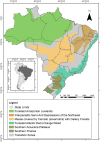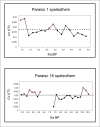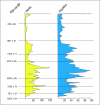Human-environment interaction during the Holocene in Eastern South America: Rapid climate changes and population dynamics
- PMID: 39899531
- PMCID: PMC11790176
- DOI: 10.1371/journal.pone.0315747
Human-environment interaction during the Holocene in Eastern South America: Rapid climate changes and population dynamics
Abstract
About 15 years ago, we suggested that the low frequency of archaeological sites dating from the mid-Holocene in several regions of Lowland South America (which was then called the "Archaic Gap") was due to an increase in the magnitude of dry periods related to the mid-Holocene hypsithermal. Since then, data regarding paleoenvironmental reconstructions for this vast area, coupled with an increase in the archaeological knowledge, allow us to reassess the idea of the "Archaic Gap" and redefine both the spatial extent of the phenomenon and its possible causes. Our present analysis aims to present a broader picture of the relations between humans and the environment in Eastern South America since the Late Pleistocene. The obtained results suggest that the extent of the areas that were somewhat depopulated during the mid-Holocene is larger than previously thought; not only Central Brazil, but parts of the Amazon and the Pantanal (close to the Bolivian border) seem to show the same pattern. However, as expected when larger datasets are available, it is possible to perceive oscillations in the archaeological signal that suggest reoccupation of some areas. Although we maintain that the main reasons underlying these patterns are related to climate, they are most probably related to an increase in climatic variability, and not necessarily to an increase in dryness. These observations are of interest to the current debate about the effects of the global warming on human populations.
Copyright: © 2025 Araujo et al. This is an open access article distributed under the terms of the Creative Commons Attribution License, which permits unrestricted use, distribution, and reproduction in any medium, provided the original author and source are credited.
Conflict of interest statement
The authors have declared that no competing interests exist.
Figures


































References
-
- Burroughs WJ. Climate Change in Prehistory ‐ The End of the Age of Chaos. Cambridge: Cambridge University Press; 2005.
-
- Barton CM, Schmich S, James SR. The ecology of human colonization in pristine landscapes. In: Barton CM, Clark GA, Yesner DR, Pearson GA, editors. The settlement of the American continents: A multidisciplinary approach to human biogeography. Tucson, AZ: University of Arizona Press; 2004. pp.138-61.
-
- Richerson PJ, Boyd R, Bettinger RL. Was Agriculture Impossible during the Pleistocene but Mandatory during the Holocene? A Climate Change Hypothesis. Am Antiq. 2001;66(3):387–411. 10.2307/2694241. - DOI
Publication types
MeSH terms
LinkOut - more resources
Full Text Sources
Medical
Miscellaneous

